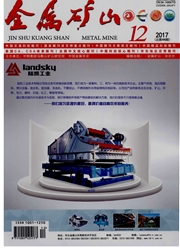

 中文摘要:
中文摘要:
基于动量和集体保存方程,堆 bioleaching 过程的一个全面模型被开发在沥滤的系统以内调查在化学反应,解决方案流动,煤气的流动,和溶质运输之间的相互作用。管理方程为联合反应流动和溶质运输用 COMSOL Multiphysics 软件数字地被解决在微规模,中央规模和宏规模层次。在或在矿石粒子的表面附近,酸集中在中央区域比那相对高,当集中坡度在沥滤的 72 d 以后减少时。在由联合 X 光检查 CT 技术的矿石粒子之间的流动模拟证明在狭窄的毛孔的最高的速度到达 0.375 m/s。在垃圾场以内的空气速度证明顶和方面表面附近的速度相对高,它在那个区域导致高氧集中。联合的热转移和液体流动过程证明答案能从堆充当一个有效搬运工,掉从 60 ~ 38 f 的最高的温度(45.9 吗??
 英文摘要:
英文摘要:
Based on the momentum and mass conservation equations, a comprehensive model of heap bioleaching process is developed to investigate the interaction between chemical reactions, solution flow, gas flow, and solute transport within the leaching system. The governing equations are solved numerically using the COMSOL Multiphysics software for the coupled reactive flow and solute transport at micro-scale, meso-scale and macro-scale levels. At or near the surface of ore particle, the acid concentration is relatively higher than that in the central area, while the concentration gradient decreases after 72 d of leaching. The flow simulation between ore particles by combining X-ray CT technology shows that the highest velocity in narrow pore reaches 0.375 m/s. The air velocity within the dump shows that the velocity near the top and side surface is relatively high, which leads to the high oxygen concentration in that area. The coupled heat transfer and liquid flow process shows that the solution can act as an effective remover from the heap, dropping the highest temperature from 60 to 38 ℃. The reagent transfer coupled with solution flow is also analyzed. The results obtained allow us to obtain a better understanding of the fundamental physical phenomenon of the bioleaching process.
 同期刊论文项目
同期刊论文项目
 同项目期刊论文
同项目期刊论文
 Investigation on the threshold control of safety blasting vibration velocity for the extraction of c
Investigation on the threshold control of safety blasting vibration velocity for the extraction of c The effect of solid components on the rheological and mechanical properties of cemented paste backfi
The effect of solid components on the rheological and mechanical properties of cemented paste backfi Leptospirillum forms a minor portion of the population in Zijinshan commercial non-aeration copper b
Leptospirillum forms a minor portion of the population in Zijinshan commercial non-aeration copper b Comparison of the electrochemical mechanism of chalcopyrite dissolution in the absence or presence o
Comparison of the electrochemical mechanism of chalcopyrite dissolution in the absence or presence o 期刊信息
期刊信息
